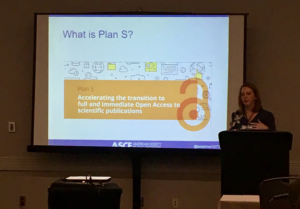MODERATOR:
Carolyn de Court
Senior Managing Editor
J&J Editorial
Cary, North Carolina
SPEAKERS:
Angela Cochran
Managing Director and Publisher
American Society of Civil Engineers
Reston, Virginia
David Weinreich
Director of Public Affairs
STM
REPORTER:
Chris Reid
Executive Publisher
Oxford University Press
New York, New York
Angela Cochran began the session with an overview of Plan S, outlining the coalition’s birth from frustrations with the slow move to Open Access (OA) publishing, and then moved on to describe Plan S’s value statement and who currently makes up the coalition. Here she shared the more recent news that Sweden has pulled out of implementing Plan S, as might United Kingdom Research Innovation, stressing some concerns about the plan and its implementation. She also highlighted the work the collation is doing with other funders and the current lack of traction it is getting. Cochran indicated that it is unclear exactly how many papers Plan S will cover, but the best estimate is around 3% of the market.1 From this, she highlighted that the countries with the largest research outputs have not joined the coalition (e.g., US, China, Germany).
Cochran then outlined the key principles of the plan and that currently 85% of journals are not compliant with these principles, including many Gold OA titles. The key points from the implementation guide to compliance were highlighted, including the following:
- OA journals should be in the Directory of Open Access Journals
- Option for a Creative Commons license (CC-BY)
- Full text XML should be in the JATS DTD
- Transparent pricing
- Automatic APC waivers for low income countries and discounts for middle income countries
- Archiving
- No mirror journals
- Moving towards a “transformative” agreement
She also highlighted the key roles of repositories and that only PubMed Central PMC currently meets the criteria. (Amendment: A few weeks after this presentation, new guidance was issued from cOALition S that makes most of the restrictive requirements a mere recommendation.)
Cochran then spoke about the practical side for journals. This included review content for Plan S-funded works and whether journals can wait for a final, clear, outline of next steps. She also highlighted the reasons not to panic, including the 700+ pieces of feedback received by Plan S; that officials are presenting mixed messages on implementation; that funders are concerned that little consultation has been done with stakeholders; and that a number of major funders are very lukewarm about the plan. Her key advice was to wait for further feedback from the coalition, but in the meantime to look at OA options for the future and keep the conversation moving with all journal stakeholders.
David Weinreich then followed by emphasizing the message not to panic about Plan S. He indicated that STM and many other publishers support the goals and principles behind Plan S, but there are many questions about implementation. He compared it to a Rorschach test from which everyone’s own views are reflected. He noted there are lots of terms like “transformational agreements” but conflicting information about what these actually are and what will happen in reality when these ideas are incorporated into funder agreements. He emphasized that the ideas being discussed around Plan S reflect the current direction of movement, and that publishers are already responding with innovations. He suggested that publishers would be wise to respond to the pressures for OA in the communities each publisher supports, rather than to simply focus on what anyone says or thinks Plan S specifically requires.
Her key advice was to wait for further feedback from the coalition, but in the meantime to look at OA options for the future and keep the conversation moving with all journal stakeholders.
Weinreich then highlighted researchers themselves, showing an increase in the number who select OA and sharing a report that 31% will choose Gold OA.2 However, OA isn’t a driving priority for researchers. Pressure is coming more from an institutional and funding level with most now having OA policies, with a strong focus on Green OA rather than Gold OA.
Weinreich then moved on to give the reminder that publishers don’t have to do anything, but if they want articles from funded researchers they will need to respond to their authors’ needs. He then explained what publishers are doing, showing that OA is growing, and that about 10% of articles are now published under Gold OA. He emphasized that publishers fully support OA but only when done in the right way, for example making things easier for authors/funders and consistent with high quality, integrity, and preservation.
Weinreich then highlighted the new options like mirror journals, read and publish, publish and read, and other potential transformative agreements, such as the forthcoming study from Information Power (funded by Wellcome and UKRI in partnership with the Association of Learned and Professional Society Publishers) looking into options, which is due in summer 2019.
Weinreich concluded by discussing new approaches for publishers and looking at where publishers offer value for authors, such as through support for compliance, new evaluation and recognition options, and metrics which go beyond the Impact Factor. The key will be to keep research and researchers in the center of all that publishers do.
Following the two talks, the most discussed question was around timing. Cochran commented that the current “deadline is blown” and that Plan S was blindsided by the amount of feedback it received. It was pointed out that this delay benefits the big commercial publishers rather than society publishers. She predicted a step back and a delay to 2021, also influenced by the change in leadership at cOAlition S. Weinreich spoke to this too, highlighting that federal agencies move slowly but that publishers should not to wait for funders to make up their minds.
References and Links

